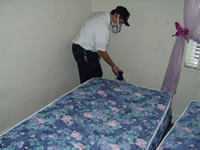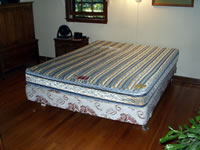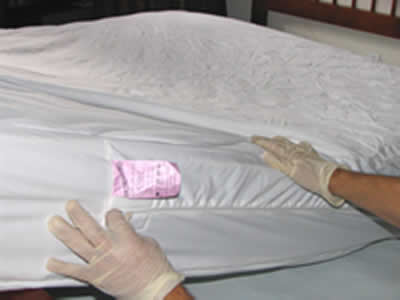 |
| Use companies experienced in bed bug control. Check references |
| Photo © Pinto & Associates |
Ten Recommendations to Help Apartment Managers Get Rid of Bed Bugs
Below are ten general recommendations to help prevent and control bed bugs in apartment buildings. Other actions may be required depending on conditions at the property and the extent of the infestation.
- Use pest control companies that are experienced with bed bug control in apartments. Get references for specific bed bug jobs and check those references. The cost will be higher than you expect (anywhere from $100 up to $750 for the initial service of a single infested unit and from $75-$300 for follow-ups). Effective companies will be charging enough to do the extensive work necessary to control bed bugs. If a company offers to control bed bugs for $50/unit, get another company.
- Be proactive. As soon as the first bed bug problem is reported and verified, assume that there are more and act aggressively. We can't emphasize this point enough: bed bug control can become extremely expensive once bed bugs become widespread. (It is not unheard-of for a property to spend $50,000 to finally "eliminate" a widespread bed bug infestation in a medium-sized apartment complex.)
- Whenever a new bed bug infestation is identified, the apartments on either side next door, and above and below need to be inspected for bed bugs. A new infestation may be overflow from a severe infestation in a nearby apartment with a resident who does not want to report their infestation for some reason.
- Every apartment that has been serviced for bed bugs should be rescheduled for inspection and treatment as necessary within 2-4 weeks.
- If a property experiences bed bug infestations scattered in different parts of a building or in multiple buildings, the infestation is likely widespread. Have the pest control contractor inspect all apartments for bed bug problems during regular rotary service.
- If a property has widespread bed bug problems, every apartment will have to be inspected and treated as necessary.
-
 |
| Residents must completely prepare for treatment for the treatment to be effective |
| Photo © Pinto & Associates |
Residents scheduled for an initial or major bed bug service need to prepare by stripping their beds, completely emptying all closets, dressers, and nightstands, washing all clothing and linens and placing them inside plastic bags or bins in the living room, and then vacuuming before service. This sounds excessive but it must be done to eliminate bed bugs in clothes and possessions, and to provide access for treatment. (See Preparation for Bed Bug Service.)
- Provide pest control service in all vacants as soon as tenants leave.
- When a new resident is scheduled to move in, provide guidance on how to make sure they don’t bring pests with them to their new home. Inspect the apartment for bed bug (and cockroach) problems 30 days after they move in and provide pest control service as necessary.
-
Residents of infested apartments should be asked to buy special bed bug proof mattress covers and put them on mattresses and box springs after treatment. The covers trap any bed bugs hidden inside the mattress and box spring so that they can’t come out and bite. They will eventually die. The covers also prevent any new bugs from finding hiding places in mattresses and box springs.
 |
| Properly designed encasements completely cover and seal the mattress and the box spring and trap bed bugs inside. |
| Photo by Richard Cooper, Cooper Pest Solutions |
Properly designed encasements completely cover and seal the mattress and the box spring and trap bed bugs inside. The bed bugs are then unable to feed and will eventually starve. In addition, once the beds are protected, other bed bugs cannot get into the mattress or box spring. They can only get on the surface of the encasement where they are easy to spot and remove.
Not all encasements will protect against bed bugs. The encasements must be both bed bug “bite proof” and “escape proof.” Low-cost encasements may be ineffective.
Choose an encasement specifically designed for bed bugs, or a quality encasement designed for people with allergies to dust mites, and expect to pay significantly more. Some encasements claim to be “bite proof’ and “escape proof” based on laboratory testing with bed bugs. Some of these were designed specifically for bed bug protection with special seams and zippers. Other encasements touted for bed bugs were designed for allergy protection, but subsequent testing has shown them to be effective against bed bugs.
Be sure to check out the following pages that provide bed bug information for apartment residents:



